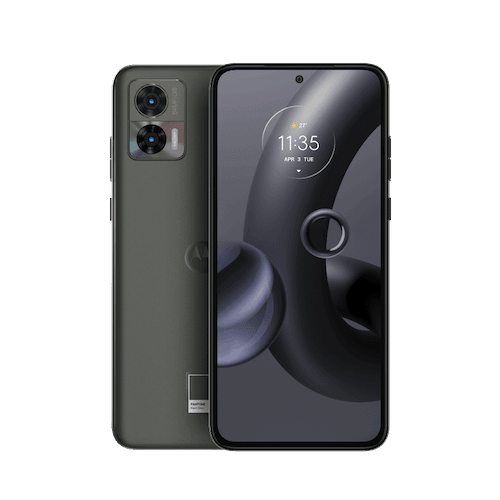Motorola Edge 30 Neo review: Thin build, thin power
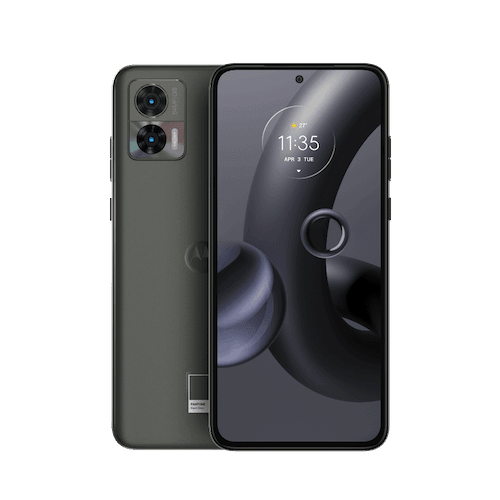
-
- Battery Score
- Camera Score
3
- Design Score
3.5
- Performance Score
3
- Battery Score
Summary
Quick verdict: Motorola’s Edge 30 Neo has some nice design style and colour choices, but there’s little that really stands out in performance or camera features to get excited about.
- Nice range of Pantone colours
- Macro camera works quite well
- Thin and light design with 120Hz capable pOLED display
- Comparatively underpowered
- Average battery life
- Camera struggles in low light
Details
Pricing & Availability
| RRP | $0 |
| Launch date | 2022-10 |
Motorola's new Edge series phones are headed up by the Edge 30 Ultra and Edge 30 Fusion phones. However, like most makers, they've also got a lower-cost option in the range, and that's the Motorola Edge 30 Neo.
It sells at a mid-range price of $599, and while the design is nice if you favour a thin and light phone, there's just not much else that really stands out against other handsets you might pick around this price point – or indeed, against a lot of other Motorola phones you could choose to buy.
Design: Did you even know there was a colour of the year?
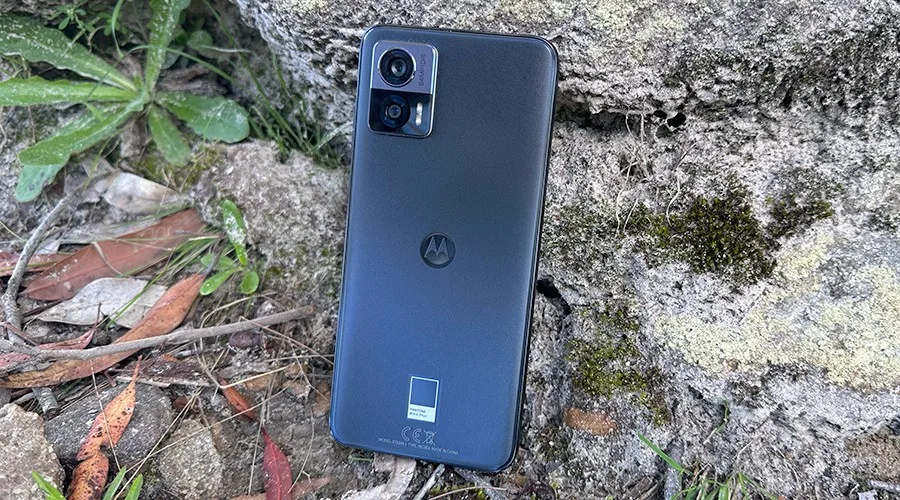
Image: Alex Kidman/Finder
Motorola's Edge phones are all distinguished by their thin frames, and the Motorola Edge 30 Neo is no different in this respect. At just 152.9 x 71.2 x 7.75mm it's a nicely balanced phone that feels good in the hand. One oddity here is that unlike Motorola's cheaper G-series phones which get simple soft gel cases, the Motorola Edge 30 Neo only gets a thin hard plastic case that doesn't entirely cover the sides.
The big story Motorola wants to tell with the Motorola Edge 30 Neo is that it is ranged in a variety of Pantone-approved colours, including Pantone's colour of the year for 2022, Very Peri. Did you know that there were colours of the year?
I don't even recall seeing a voting form, but in any case Very Peri is a purple hue, joined by Aqua Foam (a light green), Ice Palace (Silver) and Black Onyx (Black, obviously). It's the latter that I've tested with, and Motorola won't let you forget that pricey Pantone tie-in, with a Pantone Logo embossed below the Motorola batwing on the rear of the phone.
I really don't like the little Pantone logo, because it looks like I've left a QR code sticker or something on the base of my phone. Maybe that's just me, and it is at least laudable to see a wider range of colour choices in mid-range phones. Usually you're lucky to get 2 colours.
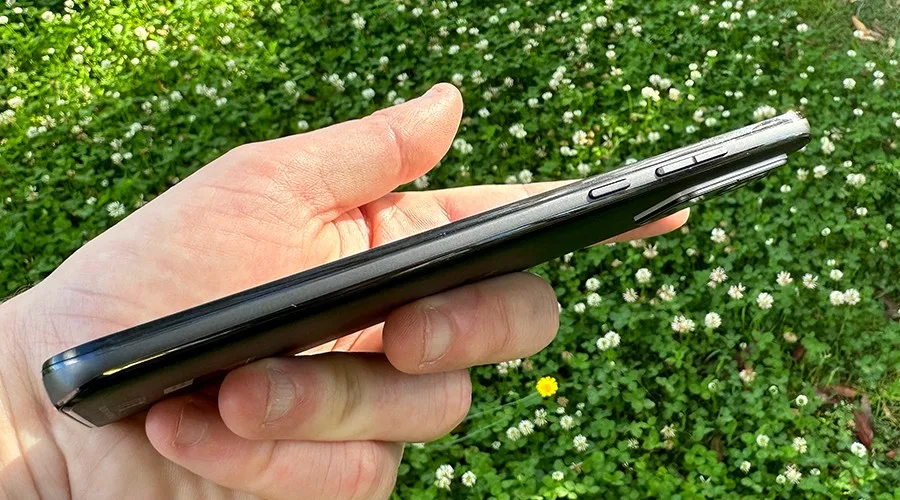
Image: Alex Kidman/Finder
Motorola has opted for an in-display fingerprint sensor on the Motorola Edge 30 Neo's 6.28 inch 120Hz capable pOLED display. I hit a few false negatives during my review period, but never had to tap more than one more time to correct this.
Motorola's been pushing higher refresh rates in its handsets for some time now, either at 90Hz or 120Hz. While it won't make every single thing you do on the phone shine, because faster refresh rates naturally work best where there's motion that needs representation, it's nice to see here.
The pOLED display on the Motorola Edge 30 Neo is nice and bright, and the embedded speakers have a decent punch to them. You'll have to make do with Bluetooth headphones or a USB-C adaptor for your private audio though, as it lacks a headphone jack.
Camera: Better than expected macro, ordinary cameras otherwise
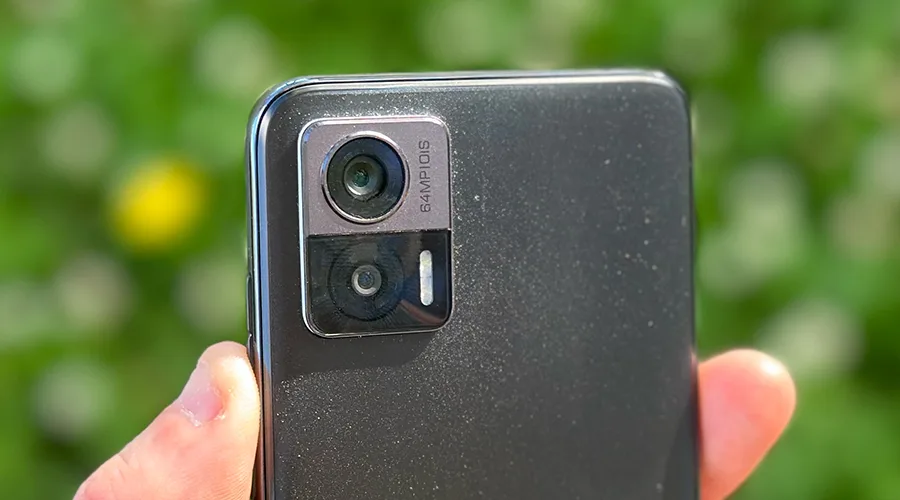
Image: Alex Kidman/Finder
A lot of the Motorola phones I've tested of late have pitched themselves as triple lens camera phones, typically via a tertiary macro lens alongside standard ultrawide and primary wide lenses.
The Motorola Edge 30 Neo does it a little different, with just 2 rear sensors to shoot with. There's a primary 64MP wide camera above a 13MP ultrawide 120-degree sensor that also does double duty as a macro lens. For selfie shooting, there's a front-facing 32MP selfie camera housed in a holepunch at the top centre of the screen.
Using the ultrawide lens as a macro shooter is a common play for this kind of sensor. The nice detail here is that it delivers macro shots that are a lot easier to get right than with the typically cruddy 2MP macro sensors that Motorola (and many of its competitors) shove onto just about every budget phone these days.

Image: Alex Kidman/Finder
What you don't get with that arrangement is any kind of true zoom capability. Having a primary 64MP sensor does give Motorola some scope for digital cropping to zoom, which it sensibly limits to just 8x digital. Still, the results are not impressive.
Here are some cockatoos I spotted snacking at a local park, taken with that primary 64MP lens without zooming:
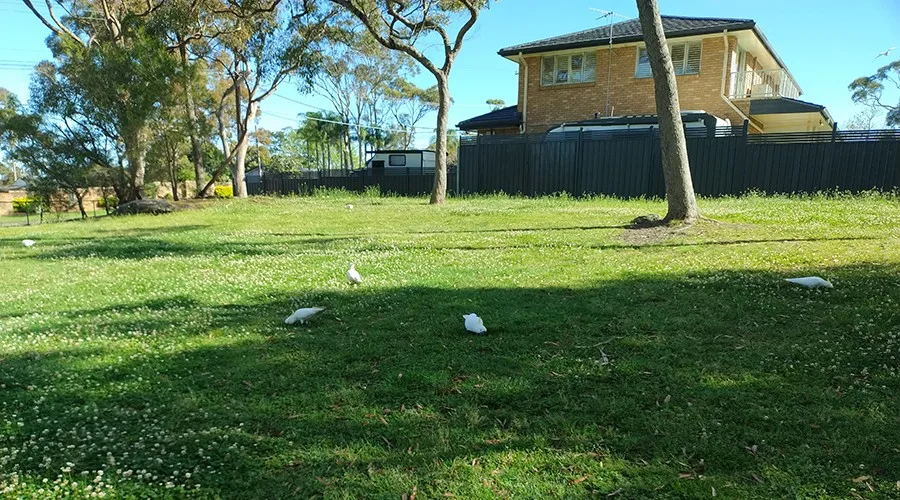
Image: Alex Kidman/Finder
And here's the 8x zoom shot:

Image: Alex Kidman/Finder
Otherwise, the Motorola Edge 30 Neo absolutely lives the mid-range phone camera life, which is to say that it's mostly average in everyday situations, but not great in any kind of way for more complex shots. Try to shoot low light with it and you'll quickly struggle. It's no worse than most in this respect – but it's also no better.
Motorola Edge 30 Neo sample photos

Image: Alex Kidman/Finder

Image: Alex Kidman/Finder

Image: Alex Kidman/Finder

Image: Alex Kidman/Finder
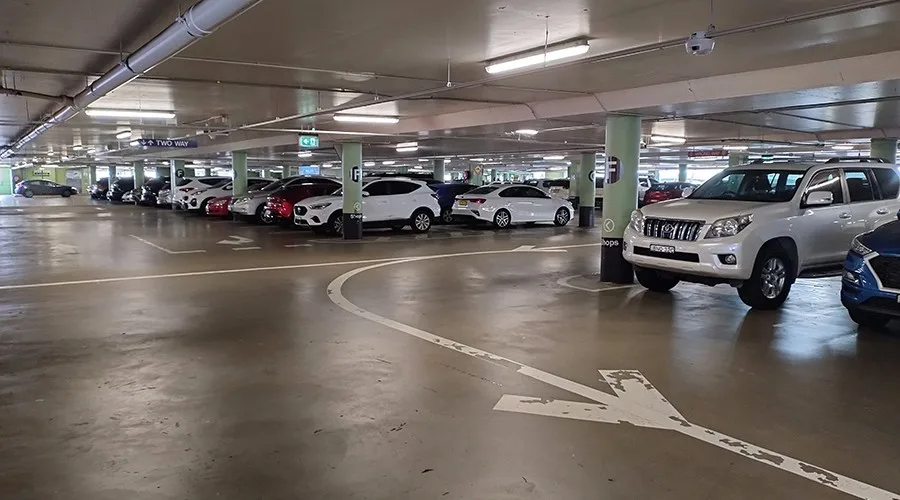
Image: Alex Kidman/Finder

Image: Alex Kidman/Finder
Performance: Mediocre
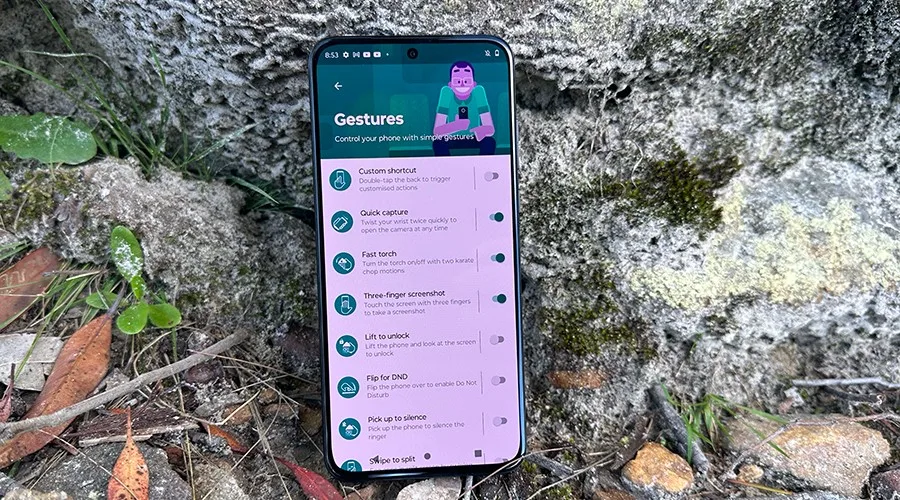
Image: Alex Kidman/Finder
The Motorola Edge 30 Neo is built on Qualcomm's Snapdragon 695 platform with 8GB of RAM and 128GB of onboard storage. Motorola does make a 256GB variant of this phone in some international markets, but that's not available officially for local buyers, which is a pity, because the Motorola Edge 30 Neo does not support external microSD cards.
The Snapdragon 695 is absolutely a mid-range processor choice, and while the inclusion of 8GB of RAM does give the phone some headroom for multi-tasking, it does fall a little short of competitors in this price bracket.
Here's how the Motorola Edge 30 Neo compares against similar phones using Geekbench's CPU test:
Here's how its Adreno 619 GPU compares against the same phones using 3DMark's Slingshot and Wild Life tests:
The Motorola Edge 30 Neo is an Android 12 phone, and I was pleased to note that it was up to date with Android security updates during my review period. That hasn't always been the case for Motorola's Android phones in the past.
What you get from Motorola is the usual array of light customisations, including familiar gestures for fast launching the camera or flashlight and its PC-side "Ready For" suite of applications. Similar to Samsung's DeX platform, this lets you either access a mobile-style view of your phone from your computer desktop, or a full desktop-style user interface.
The Motorola Edge 30 Neo isn't really powerful enough to be enough computer for most people to work that way, and I did quickly hit more lag than I wanted to deal with using the Ready For platform, but it's a nice feature to have for quick phone access as and when needed.
Battery: 4,020mAh battery outshoots expectations (but still isn't great)
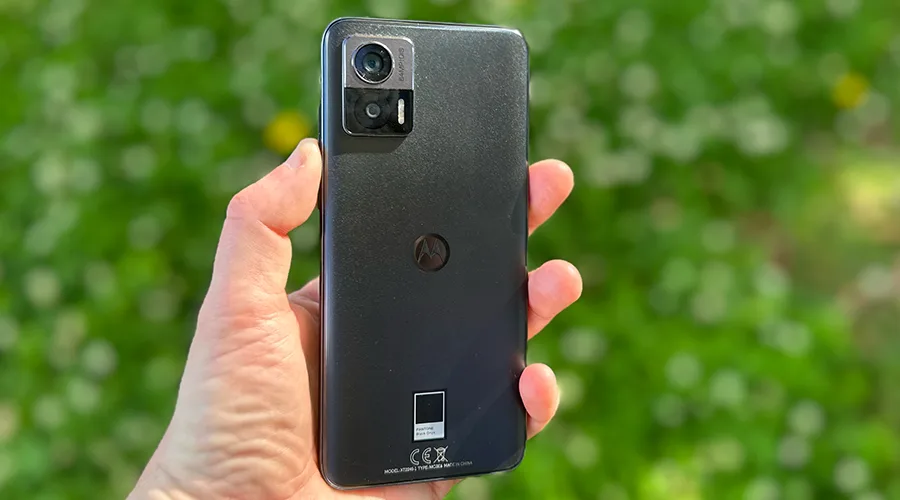
Image: Alex Kidman/Finder
Pick a given Android phone right now and the odds are very good that it's packing a 5,000mAh battery behind its frame.
Except for the Motorola Edge 30 Neo. Its thinner frame hasn't allowed Motorola quite as much space, and as a result it only has a stated battery capacity of 4,020mAh. Motorola simply refers to the Motorola Edge 30 Neo as being capable of "all day battery life" without many more specifics in play.
Combine that lower battery capacity with the obvious power needs of a 120Hz display and you could have a recipe for terrible battery life.
Thankfully, that's not the story for the Motorola Edge 30 Neo. It could do with a bigger battery, but for what it's got it runs acceptably well. Here's how it compares using Finder's battery test against similarly priced handsets:
That figure bodes well for general battery endurance, because what I typically look for is a minimum of 90% battery left over after testing. Every percentage point can add significant time to overall battery life.
In more ad-hoc tests, the Motorola Edge 30 Neo can make it through a day's moderate use with little fuss, but you'd definitely be wise to hook it up to power before you head to bed.
Here you've got a choice, because the Motorola Edge 30 Neo supports both USB C charging at up to 68W, or more leisurely Qi wireless charging at up to 5W. That's slow by wireless charging standards, no question, but it's at least wireless charging capable, which still isn't common in this mid-range space.
Should you buy the Motorola Edge 30 Neo?
- Buy it if you want a thin, smaller mid-range phone.
- Don't buy it if you want the best in performance at this price.
The Motorola Edge 30 Neo's biggest selling point is its sense of style. Most phones at this price are chunkier, heavier and larger. There's definitely a market for a lighter phone, and one that comes in a fun range of colours – yes, even the "colour of the year" if you must.
What you need to balance that against is the comparative performance of the Motorola Edge 30 Neo. It's certainly not bad, and for day-to-day usage for a regular user it would be more than enough in most cases. However, you can do better at this price point, and equally you can get slightly more capable camera phones too.
Pricing and availability
The Motorola Edge 30 Neo retails in Australia for $599.

Price
RRP: $528.00
Specifications
Display
Camera
Physical Dimensions
Connectivity
Power, storage and battery
Device features
How we tested
The Motorola Edge 30 Neo was tested over a 2-week period, running it through common benchmarks, battery tests and a range of ad-hoc usage scenarios to get an idea of its performance before comparing it against previously reviewed handsets. The model used was loaned to me by Motorola.
As a product reviewer I've got more than 20 years of experience covering the consumer tech space including hundreds of smartphones and mobile phones released in that timeframe. I'm a multi-time Australian IT Journo award winner, including winner of the 2022 Best Reviewer award.
Alex Finder
Senior editor
You are about to post a question on finder.com.au:
- Do not enter personal information (eg. surname, phone number, bank details) as your question will be made public
- finder.com.au is a financial comparison and information service, not a bank or product provider
- We cannot provide you with personal advice or recommendations
- Your answer might already be waiting – check previous questions below to see if yours has already been asked
Finder only provides general advice and factual information, so consider your own circumstances, or seek advice before you decide to act on our content. By submitting a question, you're accepting our Terms Of Service and Finder Group Privacy & Cookies Policy.
This site is protected by reCAPTCHA and the Privacy Policy and Terms of Service apply.

